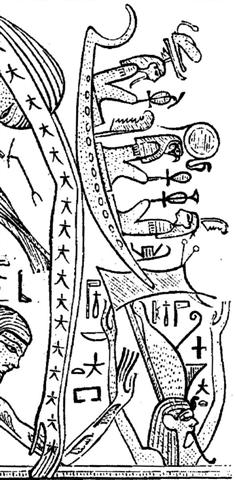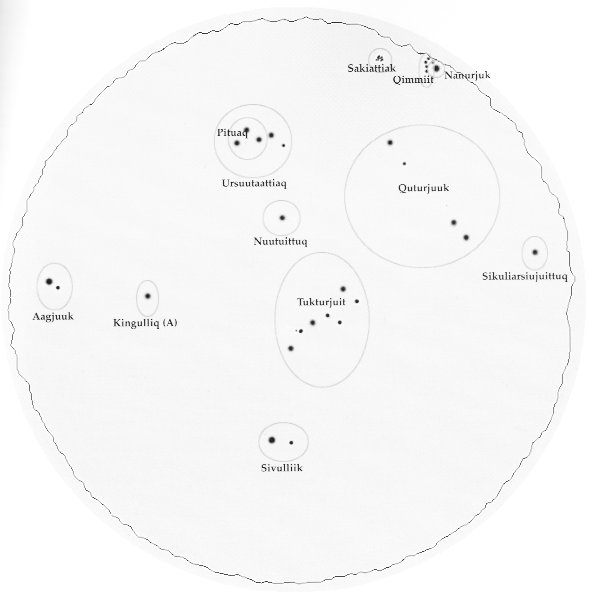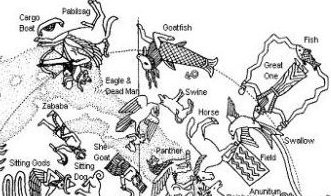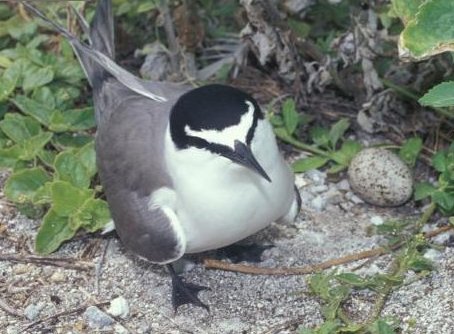Archimboldo has a pair of fruits in front of Old
Winter. Behind the sour lemon there seems to be a sweet apple.
Should we rely on the view in China the lemon ought to correspond to Jupiter
and the apple to Saturn:
|
Chinese correspondences: |
|
Elements: |
wood |
fire |
earth |
metal |
water |
|
Cardinal points: |
east |
south |
middle |
west |
north |
|
Planets: |
Jupiter |
Mars |
Saturn |
Venus |
Mercury |
|
Sense organ: |
eye |
tongue |
mouth |
nose |
ear |
|
Taste: |
sour |
bitter |
sweet |
rank |
salty |
|
Crop: |
wheat |
beans |
hirs (Panicum) |
hemp |
hirs (Setaria) |
|
Animal: |
sheep |
hen |
ox |
dog |
pig |
|
Colour: |
bluegreen |
red |
yellow |
white |
black |
There was a pair of stars which could
be observed before the Sun had gone high:
|
... string games could be resumed after
it was clear that the Sun had managed to
leave the horizon and was rapidly
gaining in altitude: 'Before the sun
starts to leave the horizon ... when it
shows only on the horizon, ... then
string games were no longer allowed as
they might lacerate the sun. Once the
sun had started to go higher and could
be seen in its entirety, string games
could be resumed, if one so wished. So
the restriction on playing string games
was only applicable during the period
between the sun's return and its rising
fully above the horizon ...
... I knew of two men who lived in
another settlement on the Noatak
river. They did not believe in the
spirit of the string figures, but said
they originated from two stars, agguk,
which are visible only when the sun has
returned after the winter night. One of
these men was inside a dance-house when
a flood of mist poured in ... His two
companions rapidly made and unmade the
figure 'Two Labrets', an action intended
to drive away the spirit of the string
figures, uttering the usual formula ...
but the mist kept pouring in ...
... Again, in a diary entry dated 18
December 1913 Jenness notes the same
Alak telling him that 'they never
played cat's cradles while two stars
called agruk were visible, just
before the long days of summer... They
played other games then, like whizzer [a
noise maker] ...
... Alak's comments indicate
that, for the Noatak area at
least, the appearance of Aagjuuk,
rather than the Sun, signalled the end
of the string-game season. And the
opinion ... that string figures came
from, and are therefore related to,
Aagjuuk may have given rise to the
prohibition against playing them after
the solstice appearance of these stars.
It is also possible that the string game
mentioned by Alak - 'Two Labrets'
- rapidly made and unmade in an attempt
to drive off the 'string figure spirit',
was intended to symbolize Aagjuuk's
two stars and so confound the
constellation with its own likeness or
spirit.
... Etalook refers to the 'aagruuk'
as 'labrets' (the circular lower-lip
ornaments of some Western Arctic Eskimo
groups, certainly evoke an astral image
if we recall that early Inuit
graphic representations of stars were
usually circular ...) giving them, it
seems, an alternate name,
ayaqhaagnailak, 'they prohibit the
playing of string games': They are the
ones that discourage playing a string
game... That's what they're called,
ayaqhaagnailak, those two stars ...
When the two stars come out where is no
daylight, people are advised not to play
a string game then, but with hii,
hii, hii... toy noisemakers of wood
or bone and braided sinew ... |
Once upon a time these twin stars
could have held a
net in place - nets are strings together with knots in an
orderly fashion - like the net which was used to
catch the long 'nose' of the Ship of the Falcon
(Horus) travelling
towards the horizon of dawn:

The pair of
Aagjuuk stars were
evidently Altair (α)
and Tarazed (γ) in the
Eagle constellation:


And the temporary Net House
of the Hawaiian goddess Haumea could
therefore have corresponded to the
time when the Sun reached Aquila:
...
The 'living god', moreover, passes the night
prior to the dismemberment of Lono in a
temporary house called 'the net house of
Kahoali'i', set up before the temple
structure where the image sleeps. In the myth
pertinent to these rites, the trickster hero -
whose father has the same name (Kuuka'ohi'alaki)
as the Kuu-image of the temple - uses a
certain 'net of Maoloha' to encircle a
house, entrapping the goddess Haumea;
whereas, Haumea (or Papa) is also
a version of La'ila'i, the archetypal
fertile woman, and the net used to entangle her
had belonged to one Makali'i, 'Pleiades'.
Just
so, the succeeding Makahiki ceremony,
following upon the putting away of the god, is
called 'the net of Maoloha', and
represents the gains in fertility accruing to
the people from the victory over Lono. A
large, loose-mesh net, filled with all kinds of
food, is shaken at a priest's command. Fallen to
earth, and to man's lot, the food is the augury
of the coming year. The fertility of nature thus
taken by humanity, a tribute-canoe of offerings
to Lono is set adrift for Kahiki,
homeland of the gods. The New Year draws to a
close. At the next full moon, a man (a tabu
transgressor) will be caught by Kahoali'i
and sacrificed. Soon after the houses and
standing images of the temple will be rebuilt:
consecrated - with more human sacrifices - to
the rites of Kuu and the projects of the
king ...
The
correspondence between the winter solstice and
the kali'i rite of the Makahiki is
arrived at as follows: ideally, the second
ceremony of 'breaking the coconut', when the
priests assemble at the temple to spot the
rising of the Pleiades, coincides with the full
moon (Hua tapu) of the twelfth lunar
month (Welehu) ...
|
Matariki i nika: |
|
The '6 stones' (Tau-ono) -
the Pleiades (Mata-riki, the
Small Eyes) - returned to
visibility.
Breaking of the Coco-nut. |
November 18 (*242)
Hua tapu (Welehu) |
|
The cycle of Lono was
beginning. |
November 28 (332) |
|
Splashing Water
(Hi'uwai).
Cycle of Lono completed. |
December 20 (354 = 6 * 59) |
|
Kali'i (Battle
of the King). |
December 21 (*275 = *242 + 33)
(Makali'i 16) |
|
The House (Haumea)
encircled by
Kahoali'i
in
the Net of Maoloha.
Lono sacrificed.
Makahiki effigy dismantled
and hidden away.
Eye swallowed by Death-is-Near,
Koke-na-make = Kahoali'i
(Living God, the Companion of the
King). |
December 23 (357)
(Makali'i 18) |
|
A tribute-canoe of offerings to
Lono was set adrift for
Kahiki, homeland of the gods. |
Once upon a time, when Aldebaran rose with the Sun
at 0h, the Kali'i (Battle of the King) probably coincided
with day 314 (*NOVEMBER 10), which was following the day of
Splashing Water (Hi'uwai) at heliacal Alshain (β
Aquilae):
|
NOVEMBER 11
(315) |
12 (*236) |
13 |
|
*NOVEMBER 7 |
8 (*232) |
9 |
 |
 |
 |
|
Gb1-6 |
Gb1-7 (236 = 472 / 2) |
Gb1-8 |
|
υ Aquilae (299.1),
TARAZED = γ Aquilae
(299.3), δ Sagittae
(299.6), π Aquilae (299.9) |
Sravana-23
TYL
= ε Draconis
(300.0), ζ Sagittae
(300.1),
ALTAIR = α Aquilae
(300.3), ο Aquilae
(300.5),
BEZEK
= η Aquilae (Ant.) (300.8) |
ι Sagittarii (301.2),
TEREBELLUM
= ω Sagittarii, ξ Aquilae (301.3),
ALSHAIN = β Aquilae
(301.6), φ Aquilae (301.8) |
|
January 14 |
15 (*300) |
16 (381) |
|
°January 10 (*295) |
11 |
12 (377) |
|
'December 18
(*272) |
19 |
20 (354)
Splashing Water |
|
"December 4 |
5 (339) |
6 (*260) |
When in Roman times Julius Caesar
in his calendar had coordinated the Sun with the
proper stars, then the battle for survival of the Sun King
had been at the winter solstice.
|
AQUILA: |
|
23 |
Sravana
(Ear) |
α, β, and γ Aquilae |
Ear or Three Footprints |
300 = 288
+ 12 |
|
- |
Altair |
Jan 15 (380) |
There were 3 stars at Sravana, but only
2 of them could have held a net high, viz.
Tarazed and Altair. Because Alshain (β)
corresponded to the lowest level of the Tree.
...
In the deep night before the image [of Lono]
is first seen, there is a Makahiki
ceremony called 'splashing-water' (hi'uwai). Kepelino
tells of sacred chiefs being carried to the
water where the people in their finery are
bathing; in the excitement created by the beauty
of their attire, 'one person was attracted to
another, and the result', says this convert to
Catholicism, 'was by no means good'. At dawn,
when the people emerged from their amorous
sport, there standing on the beach was the image
of Lono. White tapa cloth and
skins of the ka'upu bird hang from the
horizontal bar of the tall crosspiece image. The
ka'upu is almost certainly the albatross,
a migratory bird that appears in the western
Hawaiian chain - the white Lanyon albatross at
Ni'ihau Island - to breed and lay eggs in
October-November, or the beginning of the
Makahiki season ...

In the Mayan Ball Game
Sacrifice the essential rule for the
players was to try to get the ball through an
opening high up in the wall, which must have
been difficult because the ball could only be
brought up there by the proper actions of their
hips - only these were allowed to touch the
ball.
The Tree was divided in the middle at Altair and
the lower half of the gourd was aquatic in character, female.
This idea found expression e.g. in tua-papa, pelvis,
hips, because up above was the Sky Father (Ragi) and
below was Papa-tua-nuku, the Earth Mother lying with her
back side up (as Andromeda). South of the equator people were
upside down compared to north of the equator - thus Andromeda
was very far down.
|
Tua
1. Back, shoulder,
tu'a ivi, shoulder blade; tu'a
ivi more, lumbago; moa tu'a ivi
raá, 'sun-back chicken': chicken
with a yellow back which shines in the
sun. 2. Behind (a locative adverb, used
with i, ki, a, o, etc).
Tu'a-papa, pelvis, hips. Vanaga.
1. Behind, back, rear;
ki tua, after; o tua,
younger; taki tua, perineum. 2.
Sea urchin, echinus. The word must have
a germ sense indicating something
spinous which will be satisfactorily
descriptive of the sea urchin all
spines, the prawn with antennae and thin
long legs, and in the Maori the shell of
Mesodesma spissa. Tuaapapa,
haunch, hip, spine. Tuahaigoigo,
tattooing on the back. Tuahuri,
abortion; poki tuahuri, abortive
child. Tuaivi, spine, vertebræ,
back, loins; mate mai te
tuaivi,
ill at ease. Tuakana,
elder, elder brother; tuakana
tamaahina,
elder sister. Tuamouga,
mountain summit. Tuatua,
to glean. Mgv. tua: To
fell, to cut down. Ta.: tua, to
cut. Mq.: tua, to fell, to cut
down. Ma.: tua, id. Tuaki,
to disembowel. Ma.: tuaki, to
clean fish. Tuavera, the last
breadfruit spoiled by the wind. Ta.:
tuavera, burnt by the sun.
Churchill. |
|
Papa 1.
Underground rock; motionless; rocky sea
bottom; large flat stone; figuratively:
tagata papa important man, author
of great works. 2. Wooden plank
currently used much like a surf-board in
the sport called garu; it was
formerly called papa gaatu mo te
garu, because it was made from dry
totora leaves woven into the
shape of a plank. 3. To line up things
side by side on a flat surface, for
instance, to line up fish on top of a
flat stone. Vanaga.
Shoulderblade.
Papapapa, a chill, to shiver, to
tremble, to shudder. Churchill. |
The letter
β corresponded to a house
and below the crust of Middle Earth - we can see in the picture
of Yggdrasil above - there is a little house.
|
Egyptian house |
 |
Phoenician beth |
 |
Greek beta |
Β (β) |
|
...
Like the names of most other Greek
letters, the name of beta was
adopted from the acrophonic name of
the corresponding letter in
Phoenician, which was the common
Semitic word *bayt ('house').
In
the system of Greek numerals beta
had a value of 2.
... 'The traditions show that the
residences of the king were fairly
flexible. The building of new houses
was obviously the result of (male)
births in the royal family. In each
case, the house that was built last
is left to the newborn son and his
mother, together with a specific
servant, while the king has a new
and separate residence constructed
for himself
...
 |
Allen:
"To the
Arabians the classical figure [of the Aquila
constellation] became Al 'Okāb, probably
their Black Eagle, Chilmead citing this as
Alhhakhab; while their Al Nasr al Tāīr,
the Flying Eagle, was confined to α, β, and γ;
although this was contrary to their custom of
using only one star for a sky figure ...
Persian
titles were Alub, Gherges, and
Shahin tara zed, the Star-striking Falcon of
Al Nasr al Dīn, but now divided into β and γ
..."
I guess
the odd looking name Alhhakhab was a
corruption of Al Kakkab (cfr at Kochab,
β Ursae Minoris, 'an appellation perhaps given
by their nomad ancestors to β [Kochab] as nearer
the pole in their time').
...
Kaukab is the same as the Assyrian and
Chaldean word Kakkab, the Hebrew
Kōhābh; this last has also the fighting name
of Bar Cochab, the Son of a Star, who was
the leader of the second revolt of the Jews in
132-135, during the reign of Hadrian, his
shekels bearing a star over a tetrastyle
temple. The name was variosly written, but
correctly as Bar Coziba, from his
birthplace ...
As to the
Persian name
Shahin tara zed, the Star-striking Falcon,
we should remember that tara
could have implied the position of a (s)tar:

| Manu
tara Sooty
tern. The names of the age levels of the
sooty tern were earlier used as
children's names (Routledge). These
names were (Barthel): pi(u) riuriu,
kava 'eo'eo, te verovero,
and ka 'ara'ara. Fischer.
Skulls with incised carvings, imbued
with power by Makemake, were
placed in the fowl house to promote the
egg-laying capacity of the occupants. It
may seem a long call from the domestic
fowl to the sooty tern, but both are
birds and lay eggs. The sooty tern (manu
tara) comes to breed in large
numbers in July or August off the
southwestern point formed by the crater
of Rano-kao on three rocky
islets, of which the only one accessible
to swimmers is Motu-nui. (Buck) |
The fixed
stars are 0-dimensional, they are points, they have only
position.
|










